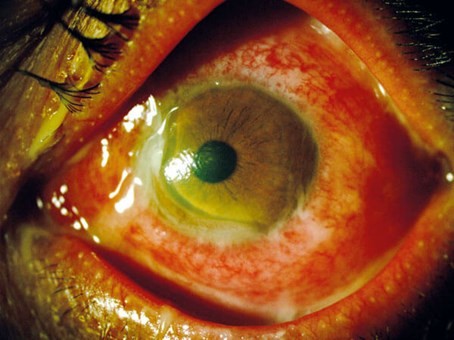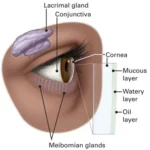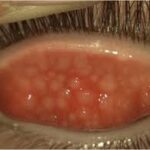Conjunctiva is a thin mucous membrane which lines the posterior surface of the eyelids and anterior aspect of the eyeball. The name of conjunctiva has been given to this mucous membrane owing to the fact that it joins the eyeball to the lids. It is divided into two portions, palpebral and bulbar. The folds or culde sac uniting the palpebral and bulbar portions are the fornices. The palpebral conjunctiva is firmly adherent to the tarsus, while the bulbar portion is freely movable over the sclera .
Conjunctivitis is an inflammation of the conjunctiva characterised by cellular infiltration and exudation. Conjunctivitis is classically defined as conjunctival hyperamia associated with a discharge which may be watery, mucopurulent, mucoid and purulent.
Types of conjunctivitis- It can divided into two types of conjunctivitis
- Infective conjunctivitis
- Allergic Conjunctivitis
Infective conjunctivitis can be subdivided into 4 types which are bacterial, viral, Ophthalmia neonatorum and granulomatous conjunctivitis
Allergic conjunctivitis can be subdivided into 6 types of conjunctivitis , Simple allergic Conjunctivitis , Vernal kerato conjunctivitis, Atopic keratoconjunctivitis, Giant papillary conjunctivitis , Phlyctenular Conjunctivitis and contact dermatoconjunctivitis.
Bacterial Conjunctivitis – This type of conjunctivitis may be caused by Staphylococcus aureus, Staphylococcus Epidermis, Streptoccoccus pneumonia, Streptococcus pyogenes, Haemophilus influenzae, Moraxella lacunata, Pseudomonas pyocyanea etc.
Acute mucopurulent Conjunctivitis- Acute mucopurulent conjunctivitis is the most common type of bacterial conjunctivitis which is characterised by conjunctival hyperamia and mucopurulent discharge from the eye. Some bacteria that causes Acute Mucopurulent Conjunctivitis such as Staphylococcus aureus , Pneumococcus, Streptococcus and Koch- weeks Bacillus etc.
Clinical Features- blurring of vision, redness of eye, foreign body sensation, photophobia, mucopurulent discharge from the eyes and colored halos around light etc.
Purulent conjunctivitis – Purulent conjunctivitis is characterised by purulent discharge from the eye and it is causedcaused by Neisseria gonorrhoeae. It occurs in two forms-
Adult purulent conjunctivitis – Clinical features of adult purulent conjunctivitis – Pain, purulent discharge from the eye, swelling of the eyelids, photophobia and blurring of vision.
Ophthalmia Neonatorum- Ophthalmia neonatorum is a bilateral inflammation of the conjunctiva which oocurs in an infant. Some causative agents that causes ophthalmia neonatorum silver nitrate is the common cause of this conjunctivitis and other causative bacteria are Staphylococcus aureus, Haemophilus species, Streptococcus haemolyticus and Streptococcus pneumoniae.
Chronic bacterial conjunctivitis – Chronic bacterial conjunctivitis is characterised by mild catarrhal inflammation of the conjunctiva. Common causative bacteria are Staphylococcus aureus, Proteus mirabilis, Klebsiella pneumonia, Escherichia coli and Moraxella lacunata etc. Clinical features – burning sensation of the eye, chronic redness of the eye, mucoid discharge , lid margin may be congested and watering.
Angular bacterial Conjunctivitis – Angular bacterial conjunctivitis is characterised by mild grade inflammation of the conjunctiva and lid margins. Common causative bacteria are Moraxella Axenfield. Clinical features – irritation, burning sensation ,redness of eye, hyeperaemia of lid margins etc.
Chlamydial Conjunctivitis – Chlamydial Conjunctivitis is the most common type of bacterial conjunctivitis, which are caused by serotypes D to K and serovarities A,B and C.
Viral conjunctivitis – It is most common cause of infectious conjunctivitis and it is highly contagious . It is chracterised by watery discharge , burning sensation etc.
Epidemic keratoconjunctivitis – This type of conjunctivitis associated with superficial punctuate keratitis (spk) . It is usually occurs in epidemics , hence the name is Epidemic keratoconjunctivitis. It is mostly caused by adenoviruses type 8,9 and 37. Clinical features- chemosis of conjunctiva , hyperaemia etc.
Follicular Conjunctivitis- It is caused by herpes viruse and adenovirus and mostly caused by adenovirus serotypes 1 to 11 and 19.
Pharyngoconjunctival fever – This type of conjunctivitis commonly associated with subtypes 3,4 and 7
Newcastle Conjunctivitis – This type of conjunctivitis caused by Newcastle virus
Herpetic Conjunctivitis – Herpetic conjunctivitis mainly occurs in small children and adolescents. This is mainly caused by herpes simplex virus type 1 and type 2
Haemorrhagic Conjunctivitis – Haemorrhagic conjunctivitis is due to picornaviruses, coxsackievirus and enterovirus 70. It is also known as Apollo Conjunctivitis . Clinical features- lacrimation , photophobia , subconjunctival haemorrhage etc.
Allergic Conjunctivitis – Allergic Conjunctivitis is the inflammation of conjunctiva due to allergic reactions of eye.
Simple allergic Conjunctivitis – Simple allergic conjunctivitis is a mild , nonspecific allergic conjunctivitis characterized by itching , hyperaemia and mild papillary response. Seasonal Allergic Conjunctivitis is a response to seasonal allergens such as tree, grass and pollens. Perennial Allergic Conjunctivitis is a response to perennial allergens such as house dust , animal dander and mite.
Vernal Keratoconjunctivitis – Vernal Conjunctivitis is a recurrent bilateral conjunctivitis which occurs on hot weather and therefore rather a summer than a spring complaint and found in young children and adolescents . It is usually seen in boys. Corneal involvement can take the form of punctate epitheliopathy , shield ulcer and secondary keratoconus . Clinical features- intense itching , Photophobia , ropy discharge of eye , Cobble stone appearance seen on palpebral conjunctiva , Trantas dots are found around the limbus.
Atopic Keratoconjunctivitis – Atopic Keratoconjunctivitis Is generally seen in young adults and often associated with atopic diseases such as asthma, allergic rhinitis in the patients. In AKC both IgE and cell mediated immune mechanism play role. Clinical features- itching, soreness, dryness of eye, mucoid discharge of eye , Photophobia etc.
Giant Papillary Conjunctivitis – Giant Papillary conjunctivitis is a foreign body associated allergic conjunctivitis characterized by formation of giant papillae on the palpebral conjunctiva. In this conjunctivitis
mainly three types of patient are affected such as soft contact lens wearer, artificial eye wearer and post operative patients with protruding ends of nylon sutures. Clinical features- mild irritation, itching , stringy discharge of eye.
Phlyctenular Conjunctivitis – Phlyctenular Conjunctivitis is an allergic reaction of the conjunctiva caused by endogenous toxins. It is characterized by bleb or nodule formation of the limbus. Clinical features – Redness with formation of bleb, Irritation , lacrimation , photophobia , pain in eye, small raised nodule found near the limbus, bulbar congestion etc.










